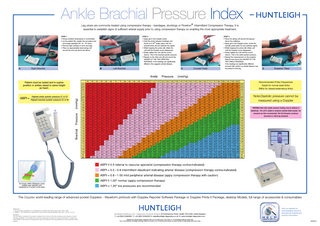Huntleigh Healthcare
Ankle Brachial Pressure Index Poster 603378-3
Poster
1 Page

Preview
Page 1
Ankle Brachial Pressure Index Leg ulcers are commonly treated using compression therapy - bandages, stockings or Flowtron® Intermittent Compression Therapy. It is essential to establish signs of sufficient arterial supply prior to using compression therapy so enabling the most appropriate treatment. STEP 1 • Ensure ambient temperature is comfortable. • Lie the patient flat, explain the procedure and encourage relaxation (for 15 - 20 mins). • Remove tight clothing on arms and legs. • Place an appropriately sized sphyg cuff around the arm just above the elbow.
A
Right Brachial
STEP 2 • Apply gel to the Doppler probe. • Hold the probe between forefinger and o thumb at a 45 angle, place over the brachial artery (A) and optimise the signal. • Whilst keeping the probe still, inflate the cuff until the Doppler sound disappears. • Slowly deflate the cuff until the sound returns. This is the brachial systolic pressure. • Repeat on the other arm (B) and record the HIGHER OF THE TWO BRACHIAL READINGS. If the readings are significantly different, this suggests arterial disease.
B
Left Brachial
C
Dorsalis Pedis
STEP 3 • Place the sphyg cuff around the leg just above the malleolus. • Apply gel to the Doppler probe, locate the dorsalis pedis pulse (C) and optimise signal. • Whilst keeping the probe still, inflate cuff until the Doppler sound disappears. • Slowly deflate the cuff until the sound returns. This is the ankle systolic pressure. • Repeat the measurement on the posterior tibial (D) and record the HIGHER OF THE TWO ANKLE READINGS. If the readings are significantly different, proceed with caution as arterial disease may be present in that leg.
D
Posterior Tibial
Recommended Probe Frequencies Easy8 for normal sized limbs 5MHz for obese/oedematous limbs
Patient must be rested and in supine position or ankles raised to same height as heart.
Note:Diastolic pressure cannot be measured using a Doppler
Highest ankle systolic pressure (C or D)
ABPI = Highest brachial systolic pressure (A or B)
*WARNING:False high systolic pressure readings may be obtained in diabetics(ie -The cuff is unable to compress calcified distal vessels). Toe pressures are then recommended. Ref-2nd European consensus document on critical leg ischaemia
The Easy8, 8MHz Widebeam probe enables easy detection and maintenance of contact of the artery
The Dopplex world leading range of advanced pocket Dopplers - Waveform printouts with Dopplex Reporter Software Package or Dopplex Printa II Package, desktop Models, full range of accessories & consumables
References: 1 Clinical Practice Guidelines “The management of patients with venous leg ulcers”, RCN, 1998. 2 Moffatt C. The Charing Cross approach to venous ulcers Nursing Standard 1990; Dec 12,5 No. 12, 6-9. Disclaimer: The information contained in this poster is believed to be correct at the time of going to print based on current European guidelines. It is intended to be used as a guide only and does not cover all risk factors. It remains the responsibility of the clinician to manage each case in accordance with local guidelines and recommended clinical practice.
Huntleigh Healthcare Ltd. - Diagnostic Products Division 35 Portmanmoor Road, Cardiff, CF24 5HN, United Kingdom T: +44 (0)29 20485885 F: +44 (0)29 20492520 E: sales@huntleigh-diagnostics.co.uk W: www.huntleigh-diagnostics.com ®
Registered No: 942245 England. Registered Office: 310-312 Dallow Road, Luton, Beds, LU1 1TD ©Huntleigh Healthcare Limited 2009 and ™ are trademarks of Huntleigh Technology Limited As our policy is one of continuous improvement, we reserve the right to modify designs without prior notice.
Visit our website for downloadable clinical & educational material and product information. 603378-3